Life and Adventures of Prince Nassau-Siegen, Russian Admiral
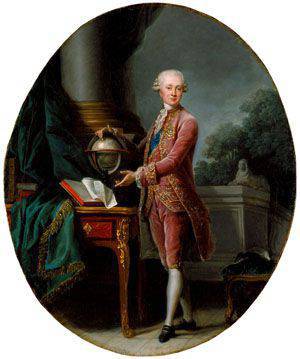
History Russia is so rich in events and personalities that in almost any of its periods it is possible to abundantly find personalities who could become prototypes of romantic characters.
The beginning of the life of Karl Heinrich Nicholas Otto Nassau-Siegen is quite in the spirit of some romantic narrative, since it can be considered a prince from the point of view of morality and inheritance rules of the XVIII century only with some degree of probability. The future condotier, explorer, soldier, sailor and admiral was born on January 5 in Picardy, in the ancestral castle of his grandmother, Duchess de Malia, divorced wife of Prince Emanuel Nassau-Siegen from the princely family of the Holy Roman Empire. The Duchess Charlotte de Mally had a side son Maximilian, who, she claimed, was the result of her meetings with her husband after the divorce. The duchess's nieces were entered not only to the court of Louis XV, but also into his bedroom, and therefore the high society of that time frowned and recognized Maximilian as a prince. A conditional father adopted his conditional son and later married a wealthy Marquis de Senarpon. Karl Heinrich Nassau-Siegen became their only son. Carl Heinrich soon lost his father, who left his son the title of prince (or prince), recognized by the Paris Parliament in 1745, and the right to land, not recognized by the Holy Roman Empire.
Around the World with Bougainville
Like many young nobles, the young man went down the military path - the belligerent Sun-King had long been lying in the grave, but France still did not miss a single, any major mess in Europe. Grandmother's connections, like connections in general, played an important role in his career, and the grandson of Duchess de Mally enters the army as adjutants to Marshal Castries - the final stage of the Seven Years War was in progress. Karl Heinrich becomes the dragoons' captain, but the Paris Peace Treaty was soon signed, and the fighting ended. In Europe, another truce is being established, and France, exhausted by casualties, is having a hard time experiencing the results of the whole lost war. The thirsty activity and adventure prince needed a lesson to consume unused energy, and, with the permission of King Louis XV, he was sent under the command of Louis Antoine, Count de Bougainville, on an 1 round-the-world expedition on the frigate la Boudeuse (Grumbler). The grumblers and the Zvezda frigates left Brest in the fall of 1766. Difficult and full of dangers and adventures so desired for Karl Heinrich, the voyage lasted 2,5 year. French ships visited Tahiti, Samoa, Hebrides. The prince was not just an observer - he surveyed the coast, helped the expedition naturalist Philibert Commerson to collect a collection of herbaria, explored the newly discovered islands, and negotiated with the natives. Seafarers had to face difficulties: the shortage of food and fresh water. All the hardships and privations of Nassau-Siegen were stoically endured along with the rest of the crew. His qualities as an officer were noted in the Bougainville report. February 16 The expedition ships 1669 arrived in Saint-Malo, a port in Brittany.
Returning from a world tour, Nassau-Siegen becomes a welcome guest at Parisian salons, where stories about his adventures are the center of attention. Ladies listen to the story of an affair with Queen Tahiti, the male half are more interested in the details of the voyage. Not content with exotic wild lands, the prince organized a hunting expedition to Central Africa, where he almost died.
Karl Heinrich willingly spun in high society, made debts and enjoyed success with women. True, the last pleasure turned into the appearance of her daughter long before the wedding. The prince, without a miss, beats the raven in Versailles Park, fights a lot in duels, in which he has never been wounded, but the aimlessness of the Brether lifestyle quickly becomes boring. In order not to be bored, he returns to military service, where he receives the rank of colonel.
Meanwhile, in Europe, they again began to talk about another war - the North American colonies that had risen against the UK demanded their place in the sun. Gallic rooster could not not seize the opportunity to peck so conveniently set up a British lion. While France was preparing to support Mr. Washington, there were also some changes in the life of Nassau-Siegen. He met in Spa traveling the rich widow of the Polish prince Sangushko, nee Gorzkaya, the daughter of a Polish governor. The prince, indiscriminately hunted, haunting and adventuring, needed funds, and he went to the “attack” of the bastions of the Polish beauty. The widow’s defense could not stand the onslaught of the “legions” of Nassau-Siegen hardened in numerous battles and campaigns, and in 1780, they played a wedding in the presence of the Polish king and settled in Sredmistye, the then (and present) VIP district of Warsaw. In fairness it should be noted that the prince loved his spouse.
Gibraltar is a toughie
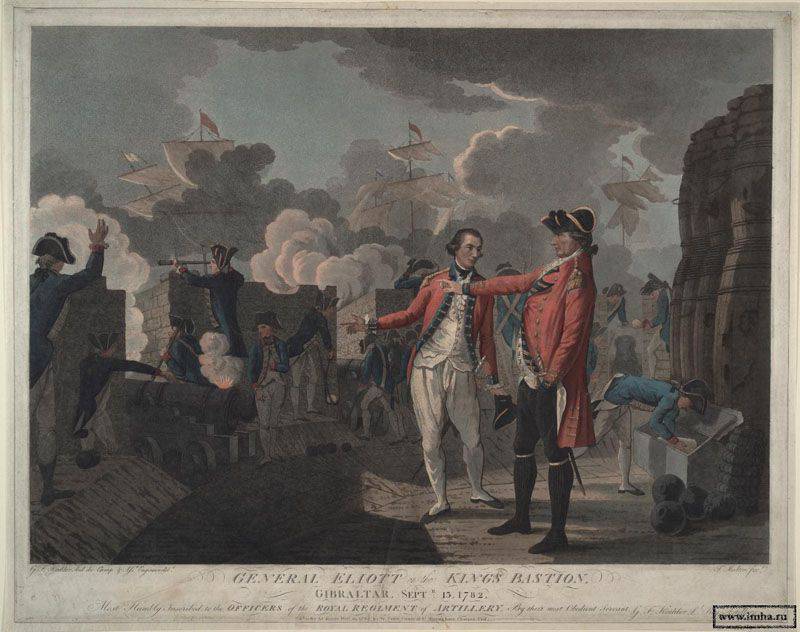
The measured family life was soon tired of the active nature of Nassau-Siegen, and he, having left the family nest that had barely begun to be created, was sent to war. The siege by the combined forces of France and Spain of the British fortress of Gibraltar, which went down in history as the Great Siege that lasted from 1779 to 1783 for a year, became a vivid episode of the American War of Independence. Gibraltar was well fortified, the narrow isthmus connecting it with mainland Spain was turned by George Augustus Elliott, Governor General and, in combination, a talented military engineer into an almost impassable obstacle. Attempts to force the British garrison to capitulate because of the famine did not lead to the desired result - several times His Majesty’s fleet broke through the blockade and delivered the necessary supplies to the besieged. Charter to take Gibraltar out of business, the Allies decided on a general assault. For its implementation was prepared 35-thousandth Franco-Spanish army under the command of the Duke de Crillon. French engineer Michaud d'Arson created heavy floating batteries, which were supposed to suppress British fortifications, after which a landing would follow. One of the batteries received under his command Carl Heinrich Nassau-Siegen. A general assault was scheduled for September 13 1782. The Allied fleet and the floating batteries opened up tight fire on the British positions, but the location of the batteries was unsuccessful, they were anchored beyond the intended positions. The British widely used hot kernels, which began to cause fires. The prince courageously commanded the battery entrusted to him, even when she was already enveloped in flames. He had to swim by swimming. The assault failed, the Allies lost all their batteries. Nevertheless, the Spanish king was granted the title of 1 class grandee for the bravery shown in battle, and the French was given the rank of major general.
After the end of the war, I had to return, although I did not want, to a quiet family life. The prince goes to Vienna to prove the right to the lands he inherited from his grandfather, but the process takes a long time. Only in 1791, the litigation ends in his favor, but the lands of Nassau-Siegen, seized by the related Orange dynasty, were by that time controlled by the troops of revolutionary France. However, it will be only after 6 years, but for now, with the intention to arrange some property affairs of the spouse, the prince returns to Poland in 1784 year. Here he is met as his own — King Stanislav Augustus and the highest nobility were gracious and gracious to him and, for a change, granted the young French general citizenship of the Rzeczpospolita.
The prince was not only a desperate chopper, a hitter and a life-seeker. Not alien to him was the commercial vein. He was carrying out a plan to organize the sale of Polish goods in the ports of the Mediterranean, using the Dniester waterway. For the success of the enterprise, he compiled the most detailed map of this major river at that time, visited Constantinople, contributing to the resumption of Polish-Turkish trade. But for the smooth implementation of plans, the prince had to enlist the support of Russia. The right people whispered to Nassau-Zigen that in the Novorossiysk southern regions Prince Potemkin runs everything, and on all important issues it is necessary to turn to him. In 1786, the European condotier and traveler went to a new country for themselves, the Russian Empire.
In the service of Her Majesty in the war against the Turks
It was lively in the south of Russia then. The sleepy wild steppe, lulled with feathers, was driven by Grigory Aleksandrovich Potemkin. From scratch he created Novorossia, erecting cities, shipyards, building ships and paving roads. He represented all the supreme power in this land and was the architect of its vertical. The formal reason for meeting with the leader of Catherine was significant - Count Xavier Branicki, a significant figure in the Polish Sejm, married to Alexander Potemkin’s niece Alexander Engelhardt, entered into a confrontation with the current king Stanislav Augustus. And it was precisely this small party who undertook to settle Nassau-Siegen and, at the same time, to solve his commercial issues between times. Two such brightest personalities met in Kremenchug. Potemkin, who had the ability to distinguish decent people from the gray crowd, immediately appreciated the usefulness of such an experienced military and political figure for his plans. After promising that his relative would make peace with the king, the prince suggested the prince to travel around Novorossia. For a European, the land he saw was an exotic place, the familiar Europe seemed too measured and boring. Virus adventurer, adventurer again activated in the hot blood of a descendant of the princes of the Holy Roman Empire. He accompanies Potemkin in Novorossia, participates in the preparation for the visit of Empress Catherine II to the Crimea in the summer of 1787. During this trip in Kiev, he was introduced to the Empress and apparently impressed her, although before that she considered Nassau to be a person with a bad reputation. But such was the frivolous 18th century, where the reputation was dried by the right side during the next coup and was soaked with blood on the guillotine.
Given the previous merits and experience of Nassau, he is invited to enter the Russian service. Having settled affairs at home and in France, the Prince arrived on February 13, 1788 in Elisavetgrad, where Potemkin met him. The next Russo-Turkish war was already in full swing, and the Most Serene was preparing to take possession of the largest Turkish fortress of the Northern Black Sea Region Ochakov. To protect the shipyards of Kherson and the water area of the Dnieper-Bug estuary, an intelligent commander for rowing was needed flotilla Liman, and Potemkin on March 26 appoints Nassau-Siegen to this post in the rank of rear admiral. So the German prince, the French general, the Spanish grand, the Polish magnate became the Russian rear admiral and began his service in Russia.
At the walls of Ochakov
In the spring of 1788, to the beginning of navigation, the flotilla was not in the best condition. The ships were built hastily from not until the end of the dried forest. There were few officers and, most importantly, lower ranks with combat experience. Upon arrival, Nassau began intensive training in combat training, despite the difficulties, primarily language. Sailors called him “Mushroom Pie”, because at the beginning of the Russian period of his military career he knew only two Russian words: “forward” and “row”, pronounced with the appropriate accent, like “pie” and “mushrooms”. Meanwhile, in his reports and letters to his wife, which he, while being separated from her, wrote constantly, Nassau-Siegen strongly emphasizes the abilities and diligence of Russian sailors. They did not have time to bring the flotilla to good condition - on May 20, the Turkish fleet under the command of Gassan Pasha approached Ochakov. These were impressive forces made up of 12 battleships, 13 frigates, 2 bombing ships, and a couple of dozen ships of smaller ranks. On the Turkish ships there were several hundred Englishmen as mercenaries and instructors - officers and gunners. The rowing flotilla opposed to this armada consisted of a 51 pennant and looked much more modest: 7 galleys, 7 dubel boats, 7 floating batteries, 22 sea boats, 7 deck bots and 1 brander. In addition, there was a squadron of sailing ships under the command of Scottish-born American Paul Jones (2 battleship, 4 frigate and 8 smaller ships), also in the rank of rear admiral. Both admirals were jealous of the experience and glory of each other and were in strained relationships, which did not prevent them from achieving success. Both commanders of General A.S. Suvorov, then the commandant of Kinburn.

From 20 May to 6 June 1788, the Turkish fleet stood idle in the sight of Ochakov, supporting his presence with its garrison. In the morning of June 7, in the morning of 4, Gassan Pasha decided to attack, but the Russians were on the alert and they were not caught off guard. The galleys of Prince Nassau and the ships of Jones rushed at the enemy, causing him damage. Having lost three galleys during the battle (two were blown up, one burned down), the Turks retreated to their main forces. Harassment by force of the opposite wind and current was not made. Potemkin, in the most eloquent terms, painted for Catherine the actions of the Liman squadron and her commander, emphasizing his courage and skill. While the success story was going to Petersburg, Ochakov had new events. Gassan Pasha, dissatisfied with the outcome of the first clashes, decided to seriously try Russian to tooth. 16 June 1788, the Turkish fleet moved to the Russian ships looming in the distance - the Turkish commander himself headed the attack on his 64-gun flagship. The fury of the Turks was so great that in the heat of the attack the battleship Gassan Pasha ran aground. The rest of the squadron ships surrounded him to assist. The whole day was spent in skirmishes at a great distance, as well as at the beginning of the written, and then the verbal skirmish between the two rear admirals. Nassau-Siegen demanded to attack the stranded flagship immediately, with all its might. Paul Jones rightly objected that the shoals were dangerous for his deep-sinking ships. While the cocktail was boiling with German rage, Gallic rage and Scottish stubbornness, the Turks were able to pull off their flagship.
Early in the morning of June 17, reinforcements arrived at the Nassau-Siegen flotilla: 22 gunboats with 18-pounders, which descended along the Dnieper from Kremenchuk. Strengthened, the Russians themselves attacked the Turkish fleet. The Turkish flagship was not lucky again - during maneuvering, he again ran aground. But this time they did not give him a chance to escape, the ship was set on fire by a firefighter and soon burned down. The battle lasted 4,5 hours, then part of the Turkish ships moved to the open sea, and the other - went under the protection of Ochakov. The Russian victory was complete: the Turks lost their 3 battleships, 5 frigates, 1 shebeks and 1 brigantines. One battleship was captured and sent to Kherson for repair. During the two-day battle in the Turkish squadron, more than 6 thousands of people were killed and drowned. 1600 was captivated. The Liman squadron had no casualties in ships, 2 officer and 16 lower ranks were killed, 70 people were injured. After the battle, the admiral enthusiastically wrote to his wife: “There is no one braver than a Russian!” Prince Nassau was awarded the Order of St. George of the II degree for this fight, as presented by Potemkin. The Empress granted him the eternal use of 3000 souls of serfs in the Mogilev province.
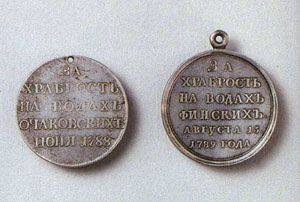
After the battle, the 12 of the Turkish ships, embarrassing Potemkin, remained under the walls of Ochakov. He ordered Nassau-Siegen to attack them. 1 July 1788, his flotilla approached the fortress and, despite the hurricane shelling from coastal fortifications, 11 of enemy ships was destroyed, and one galley, 50-rowing Makroplya, was captured as a trophy and sent to Kherson. Catherine was pleased with another victory - on July XNUM she awarded Nassau a richly decorated sword, and for the lower ranks almost 14 thousands of memorable silver medals were sent. He was allowed to hoist the vice admiral flag on his flagship. Encouraged by the support of the empress, the prince began to give Potemkin more and more advice on the organization of the siege of Ochakov. At the 5 October Military Council, the admiral presented his plan to assault the fortress, where a large role was assigned to the actions of the flotilla entrusted to him. Potemkin publicly ridiculed him. The fame of the foreign admiral confused the Most Serene Light, and he decided to put the one in place. Offended Nassau, referring to the disease, surrendered command and went to St. Petersburg. There, 10 of December was very cordially received by Catherine, recognizing his merits, and sent him away from swearing affairs to a secret diplomatic mission abroad for making a coalition from Austria, France and Spain to calm her down. The empress transparently hinted that on her return Nassau would be promoted.
In the Baltic - from a glorious victory to a crushing defeat
While land and sea battles were seething in the south of Russia, in the north of the empire also smelled the smoke of war. Another old and persistent enemy, Sweden, laid out his blade in the hope of a rematch. Back in 1787, admiral S.K. Greig proposed to repeat the Archipelago expedition of the Baltic Fleet. The Russian squadron with the 10-thousandth airborne corps was again to go around Europe and act in the Aegean Sea basin, creating a threat to the Dardanelles and dragging off part of the enemy forces from the Black Sea. The preparations of the Russian ships for the campaign were very ingeniously used by diplomats of some European "partners", primarily England and Holland, to intimidate and incite the Swedish court. The growth of anti-Russian sentiment at the court of King Gustav III was promoted by a difficult domestic political situation. And hints of enlightened navigators that, they say, the fleet in Kronstadt is actually preparing to jump into the Gulf of Bothnia, lay down on fertile and well-plowed soil. The leaders of European maritime trade did not need Russia's presence on the Mediterranean, as indeed now. 21 June 1788, the Swedes began fighting. Catherine II was presented with a bold ultimatum, in response to which the empress simply ordered the Swedish embassy to be expelled from St. Petersburg.
Returned from a foreign voyage, Nassau was appointed, with a rise, as the chief commander of the Baltic Sea rowing fleet in May 1788, on the eve of the war. As in the Black Sea, the vice-admiral found the forces entrusted to him in a very poor condition: the ships were often in poor technical condition, the teams were poorly trained. Many crew members, especially from the latest recruiting kits, were not even familiar with the sea. And then the active admiral made every effort to create an effective connection from this mass. The fate of the campaign depended on the fleet and rowing fleet. Ground actions in the swamps and forests of Karelia and Finland were carried out with limited forces on both sides. The Swedish fleet, which King Gustav III devoted a lot of time and money, consisted of 23 battleships, 11 large frigates, rowing forces totaled 140 units - this fleet was an impressive force not only in quantity, but also in quality.
August 22 Swedish rowing flotilla under the command of Admiral K.A. Ehrensverda, numbering at least 50 ships, embarked on a raid on the Swedish fortress Rochensalm (present-day Finnish Kotka). With the squadron, there were about 30 transports for the transportation of the planned landing. The Swedes considered themselves safe, having blocked the Rochensalm Strait, the only accessible for large ships, flooded three old vehicles. In the same area, Russian galery forces concentrated in the number of 86 ships under the command of Vice-Admiral Nassau-Siegen. Personally conducting a reconnaissance, he develops a battle plan. 24 August, the Swedes were attacked from two sides at once: a part of the Russian ships (20 pennants) distracted the attention of the enemy, and the second cut down a passage with the help of special teams of carpenters, simultaneously firing. Four hours later, the victory was complete: the Swedish squadron was completely crushed, losing 40 ships, more than 1000 people killed and drowned and 1200 - prisoners. During the flight from the raid, the Swedes burned all their transport ships. Nassau-Siegen lost two ships. Many officers distinguished themselves in the battle, among them was Lieutenant Alexei Kornilov, the father of the future renowned admiral V.A. Kornilov. For his bravery, he was awarded the Order of St. George 4 degree. The commander of 19 August himself was awarded the highest award of the Russian Empire - the Order of St. Andrew the First-Called. Encouraged by the success, Nassau-Siegen insisted on preparing the landing operation in the rear of the Swedish army, but the slow and cautious commander of the ground forces General-in-Chief Musin-Pushkin did not seize the moment, and the war continued.
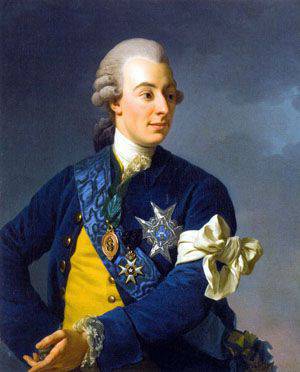
In the 1790 campaign of the year, the command of the fleet was headed personally by King Gustav III. He also hoped to seize the initiative from the Russians. The Swedish attempt to assault Vyborg in June 1790 did not succeed. As a result, the Swedish fleet blocked in Vyborg Bay broke through 4 July in Sveaborg with heavy losses. Galerny, or, as the Swedes called him, the navy fleet, embarked on the roads of Rochensalm and began to prepare for defense. King Gustav and his officers took into account the lessons from the first battle that took place here a year ago — coastal batteries were equipped on numerous islands. The fleet commander Chichagov demanded from Nassau-Siegen a final solution to the problem of the Swedish skerny fleet. The Vice Admiral was confident in his forces and did not wait for the reinforcements promised to him. Perhaps for personal reasons, Nassau did not want to share his fame with anyone, especially since he tried to celebrate the right, in his opinion, victory on the throne's ascension to Catherine II. The history will show how tragic in the history of Russia are the sea battles dedicated to the dates of the coronation of royal persons: recall at least the Tsushima battle, which Rozhdestvensky wanted to coincide with the coronation day of Nicholas II.
By the beginning of the Second Battle of Rochensalm, the Swedish forces numbered 6 frigates, 16 galleys and 154 small galleys and gunboats with almost 13 personnel of thousands of people. The Nassau-Siegen had 20 rowing frigates, about 40 large galleries and shebeks, 77 galleys and bombing ships, a dozen auxiliary vessels carrying almost 18 thousands of people. Vice-Admiral decided to act dashing attack, despite the fact that the attack was not favorable weather, and the teams were tired of the transition and maneuvering. On the night of July 9 Russian ships rushed to the attack. Unlike the first battle, it was decided to break into the Rochensalmsk raid on one side only. The Swedish position was strong - Gustav III built his fleet with an L-shaped anchor position. Behind the first lines were carried out the transfer and maneuvers to threatening directions with bombing ships and gunboats. Hurricane fire was fought in advance equipped coastal batteries. Unable to withstand the dense effects of artillery, the Russian galleys began to retreat. The storm sea was finished off by ships damaged by enemy fire, several ships were thrown onto the shore, where they were burned by carriages. Not having a stroke due to damage - were taken to the boarding. On the second day, the Swedes counterattacked and forced Nassau-Siegen to move away from Rochensalm. The admiral behaved courageously and bravely in battle. According to the stories of those nearby, when the outcome of the battle became obviously unfavorable, he was looking for death in battle. Its flagship, the rowing frigate Katerina, was boarded and captured as a result of a fierce battle. Admiral with the use of force managed at the last moment to ship to another ship. The defeat was heavy: the Russian fleet lost about 60 ships, 7500 killed, wounded and prisoners. The enemy losses were minor: small ships 5. The second Battle of Rochensalms was the largest battle on the Baltic Sea, in which the Russian fleet suffered a most crushing defeat, even tragic Tsushima.
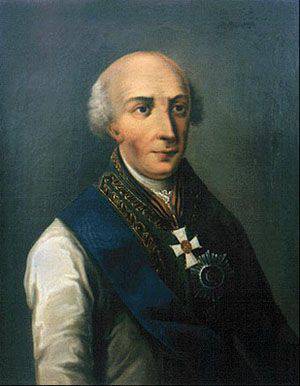
Shocked by the defeat, Nassau-Siegen sends all his awards to Catherine II, considering himself unworthy of them. He asked to be prosecuted. However, the empress sympathetic to him returned the regalia, along with a comforting letter, in which she tried to raise the spirit of the admiral, complaining that anything could happen. Nassau is developing a thorough plan for a new attack of the Rochensalmsk raid, but in August 1790 of the year the Welsh Peace is signed and the war ends. In December of the same year, Nassau was awarded a gold sword with diamonds, the rank of admiral and a silver service. Nevertheless, he grieved his failure in the Swedish war, caused, in his own opinion, by excessive self-confidence and pride. In May, 1792, he was dismissed on long overseas leave, receiving 20 thousand rubles for expenses.
Settling in Koblenz, the admiral lived in a big way, and around him a whole company quickly formed from the beating French of varying degrees of nobility and arrogance. In France, the revolution was raging with might and main, and Europe was filled with political immigrants. In his charity, the prince went so far as to be aground. In November 1793, he returned to Russia, where he again commanded the rowing fleet, but his service did not last long. After repeated requests for resignation in October, 1794 Nassau-Siegen was finally dismissed with full content.
And in the heart of the thunderstorm subsided. Last years
Nassau-Siegen settled in the Russian Empire, in his estate in Tynn (now Khmelnitsky region in Ukraine), where he plunged into economic concerns. The former traveler and the military, who lived a life that can be counted in several adventure novels, is now engaged in agriculture. Perhaps the thirst for adventure, campaigns and wars, as well as decent content, draining the prince throughout his life, was finally satisfied. He outlived his beloved wife who passed away from a fever in the Crimea. And he went to his long-awaited colleagues and soplavateley in 1808 year in Tõnn. His crypt was destroyed at the end of the 20th century and was not preserved.
Prince Nassau-Siegen was, like many, a foreigner in the Russian service, but became part of our history. This personality fully embodied the Western character, prompting him to cross the oceans and participate in foreign battles in search of gold and fame. A soldier, an adventurer, a traveler, a sailor and an admiral, he was the son of his era - a brilliant, bloody, frivolous, smelling of exquisite perfumes and gunpowder fumes of the 18th century.
Information